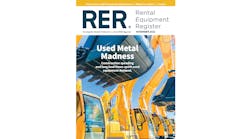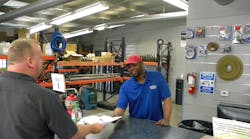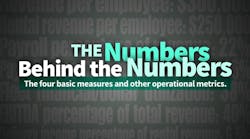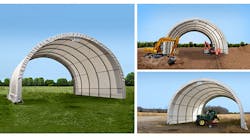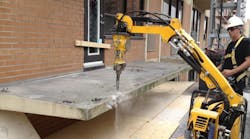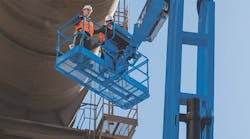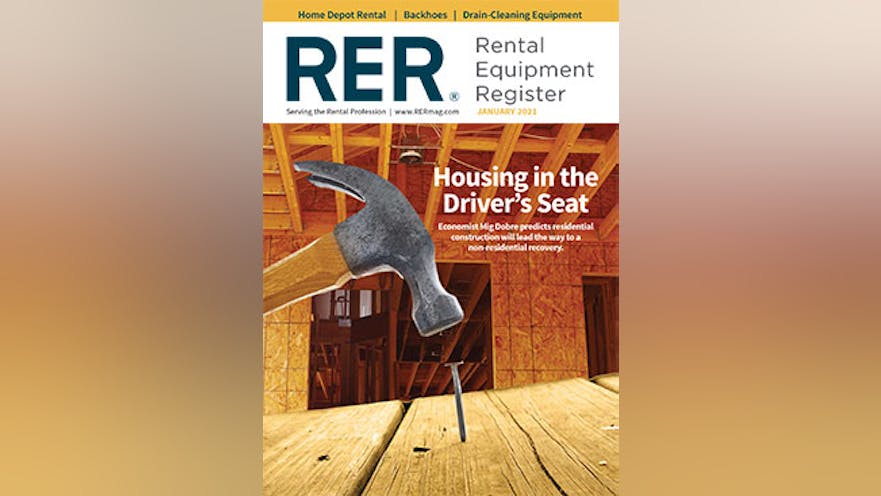RER talks with Mircea “Mig” Dobre, senior analyst – machinery & diversified industrial for Robert W. Baird & Co. – about residential and non-residential construction in the next couple of years, the prospects for infrastructure development, the long-term effects of the pandemic, and how strong management saved rental in 2020. And more!
RER: Obviously until we have a strong vaccine well-distributed, available and accessible, we will essentially have a pandemic economy. Given that we may have that fairly soon, what are your expectations for 2021?
Dobre: You’re right, the economy will be a pandemic economy as you call it the first half of the year, but a vaccine will be extremely important for confidence. It allows people to plan because you do have to make plans in 2021 with an eye to what might happen in 2022 and 2023. That applies to capital expenditures, it applies to investments and other real assets like building. I agree that nothing will change overnight, but I do expect that we’re going to see real positive effects from the vaccine rollout in the second half of 2021 and that 2022 activity is going to pick up quite a bit as a result.
I think 2021 is going to be a year of good growth, but you have to remember that for a good portion of 2020 a large portion of the country was in lockdown. All of this combined with good action on the part of Congress on the stimulus front, I think that we’ll see more after January 20 as the new administration kind of looks for priorities, all of those items will be supportive of growth in 2021 and into 2022.
Do you expect to see any long-term effects on the economy from 2020’s pandemic-induced downturn?
One of the big questions that will stick with us and will have to be figured out is how we are all going to conduct our work on a go-forward basis. We have learned from the pandemic that working from home, working from remote locations, is frankly efficient and, in many ways, it saves resources, it saves money and it saves time. Remote work is not perfect. For us, for example, an investment bank, it’s very difficult to train new employees, and we do have turnover. I don’t subscribe to the idea that the traditional office space is gone. I just think it’s likely to be re-worked and re-imagined, and perhaps we are going to need less of it. That might be the biggest potential change that comes out of COVID.
The other one has to do with structural business travel. Even with the vaccine I think business travel is going to be lower than it’s been in the past. That does have an impact on hotel construction, business travel is really important to that market and it also impacts future airport construction and transportation. This is sort of a longer-term view. But if I were to guess which vertical might be the most impacted, I’d probably have to pick the office vertical.
Maybe the office becomes more of a place where people get together to meet and we don’t require offices to work in as much?
It’s interesting because we are going through this exercise and trying to figure this out for ourselves in my firm. Re-imagining the office can mean many things. One of the things that has happened in office settings over the past 10 or 15 years is the elimination of walls, everyone migrated towards share spaces to foster communication. Well, maybe we’ll go back to a more separated environment, where you can actually close the door and have your own private space, I think again that might actually increase the amount of space needed, not decrease the amount of space needed, right?
That would be one tendency, if that materialized, it might drive incremental business. I think you’re right, the overall effect of what we’re talking about here is we’re probably going to see lower presence in the actual office. Most professional services employees are likely to migrate towards a mixed model, a few days in, a few days of work from home, so that flexibility is going to be valued.
So, we’re going to go through a period of adaptation for folks who are operating in that construction vertical and that will probably be with us the next couple of years.
What will be the impacts of a Biden presidency?
Talking about a Biden presidency, there are so many angles to this and I think one of the very obvious ones is that a Biden administration is likely to be very much focused on getting an infrastructure package put forth and hopefully passed by Congress. This is very much the top priority to them. If they are going to be successful, this can be material in helping the construction industry and the rental equipment industry. And, of course, what’s embedded in this infrastructure initiative is also the greening of the U.S. economy. There’s a lot in there that addresses retrofitting existing buildings, so it’s not just new construction but the retrofitting of existing infrastructure in place that I think is going to have some very meaningful, positive effects for American industrial companies. I mean electrical equipment providers, lighting providers, all the way to just outright new construction and rental equipment.
I expect the potential for more bipartisanship than we’ve seen in the past eight to 12 years.
There was a poll conducted prior to the election that shows 70 percent of Americans support investment in infrastructure. So, it’s a hugely popular issue.
Any chance of an infrastructure bill or highway funding bill in 2021?
The ideal situation for all parties involved is to actually have a broader infrastructure bill rather than just a simple replacement to the FAST Act. We’re obviously not just talking about a narrow component, which is addressed by the FAST Act but something that goes all the way to building retrofits, just a broader scope in general. I think that would be the best outcome. In terms of there being a chance of it, I think there is. There’s definitely a non-zero chance, it’s just difficult for me to ascribe an actual probability at this point.
What are your expectations for non-residential construction? We already discussed office construction, what about some other segments?
My view on non-residential construction and just sort of the general sense from everyone, is that it will be challenged in 2021. Our expectation is that non-residential construction, the private side of non-residential will decline about 11 percentage points in 2021. But if you look at the cadence with which these declines will manifest, I think the first half of the year is where we’re going to see a good portion of that compression.
My expectations are that in the second half these declines will start to moderate a bit. No, I don’t expect that we’ll exit the year with non-residential being up in November and December, I think the declines will continue through the year, I just think the declines are going to be less bad as we approach year end. One of the really important things to recognize here is that non-residential construction has two big macro drivers. One of them is residential construction and the other is GDP growth. So if you think about residential, especially if you’re putting up a new subdivision with new single-family homes, those eventually need to be supported by nonresidential structures -- convenience stores, gas stations and other businesses. So residential and single-family homes specifically do have an impact on future non-residential demands.
GDP growth, broad economic growth is similar, you can’t really grow the economy without having space available to conduct business. If the economy is growing, that means you’re probably going to need more warehouses. If eCommerce is growing you’re going to need more warehouses, right? You can kind of apply that to a number of the verticals that you see in non-residential construction. Manufacturing is a good example. If the economy is growing. If we’re looking to re-shore some of the things that in the past we imported from abroad, and by the way I don’t think that trend, that desire is going to go away any time soon, so if we’re looking to do all these things, we are going to have to invest in manufacturing, and that’s an important component of non-residential construction.
The last one -- and this is actually the biggest -- is power. We have tremendous needs when it comes to the electricity grid in the U.S. You know this in California. What you’ve been going through just highlights how much we have to do to upgrade and re-tool what really is an aged infrastructure, an aged grid. If the economy is growing and residential is growing, that’s going to have a positive effect on non-residential construction. Historically, residential and GDP lead non-residential construction by about 18 months on average.
So the hit that we’re experiencing in nonresidential construction -- and nonres has been declining through 2020, and I’m saying it’s going to decline again in 2021 -- the hit that we’re experiencing in nonresidential construction in 2021 is on the heels of a challenged residential market in 2019. We’re experiencing the echo of residential being down in 2019, the hit that we’ve taken to GDP in 2020 because of the coronavirus pandemic, that potentially stretches the decline into 2021, but as we look into 2022 with the economy back to growth, with residential growing, I think non-residential construction will actually start to grow again. So, I think overall construction activity is going to accelerate in 2022 relative to 2021. Overall construction because I expect residential is going to grow.
If you think about the moving pieces, you’ve got three pieces to construction: you’ve got the public piece, you’ve got the private non-residential side and you’ve got residential. If residential continues to grow, if non-residential returns to growth in 2022 and public continues to grow, which it will, potentially an infrastructure stimulus will continue to boost that, then 2022 might be a fantastic year for growth, for the construction industry and rental in general.
What do you think of the oil-and-gas market coming up?
This one is a tricky market. I think the oil-and-gas market has some long-term structural challenges because this drive towards lower fuel consumption and electric vehicles is not going away any time soon. However, whether it’s pipeline, whether it’s refineries, they do need to be mentioned. As you look at crude oil prices rebounding off the woes, I actually think positive effects can happen at anything above $40 a barrel; that will be conducive to investments. We’re going to see this market slowly start to regain its footing.
But what’s going to be different is I don’t expect another mini-energy boom. I think that operators are going to sweat assets, they’re going to be very careful about how they’re deploying capex. So I’m thinking about the progression of this market, our expectations are for flat to slight decline for 2021 as a whole. We’re thinking that the year is going to start in the red basically with some growth in the back half of 2021 and slightly better growth in 2022. But again, this is not going to be a boom market the way we have seen it in prior cycles.
I assume that means not another fracking boom, right?
I think that’s pretty much off the table.
You have been very bullish about housing over the past few years. What about the residential market for 2021 – multi-family and single-family?
If you look at the housing stats, they show that year-end construction, unlike prior recessions, the pandemic has been positive for the housing market. You’re asking if I am still a housing bull. The short answer is absolutely I am. I think housing will be a fantastic market over the next several years and there are drivers here that are really important.
One of them, and this is the one that I’m most excited about, is demographic, a generational one. Look at what is happening with household formation. We are forming households at the fastest clip in decades and that’s because millennials are finally getting married and they are looking to start families. And it took a while, but the kids are moving out. I think that cannot be overlooked. The demand for housing from these households is going to be very different from when they were single, when they could live with roommates. When a tiny 700-square-foot apartment in the city made sense. Now they are looking in suburbs for 2500-square-foot homes. Their requirements are very different.
You see it in the data, it’s not just hypothetical, it’s in the data. I think homebuilders know this. And this is where you see it -- in the NAHB housing market index. Homeowner confidence following this pandemic has hit a high not seen since 1985 because they are recognizing the positive demographics. They are recognizing what I think is becoming an emerging trend, individuals looking to live outside the cities rather than in the cities.
The other thing worth knowing here is the interest rate environment would be highly supportive. Mortgage rates have hit another low, we’re talking about 30-year mortgage rates that are less than 2.7 percent, that’s incredibly affordable. So, to add maybe fuel to this fire, you asked about the effects of a Biden presidency, well, here’s another one. The incoming administration is talking about cancelling student debt. Student debt is really important for the housing market.
If you have this massive debt, how can you buy a house, right?
Correct. If you have a lower student debt burden, your ability to afford a mortgage, and a bigger mortgage, goes up and goes up significantly. So, the cancellation of even a portion of student debt is going to very much fuel, in my opinion, home ownership
among those who are forming households as we speak. I think the future is quite bright for housing.
Some expect the impact of canceled projects to keep the economy in a lull. With 2020 already a difficult year in rental, how will rental companies deal with the challenges of 2021?
Rental companies have done a really good job in 2020, the industry has been remarkable in 2020 because the pandemic has provided operators with frankly a bit of a preview of the downturn that is to come in non-residential construction. It’s interesting, if you look at put-in-place construction activity, relative to 2019, the pandemic shut things down for a couple of months; then we got back to work and everybody got back to eventually completing the work that was in the pipeline already. So rental operators recognized that backlogs were going to be depleted, and many sharply reduced capital expenditures. Many started selling units from their existing equipment base.
So the result is smaller fleets, that’s something that United Rentals called out and Herc and Sunbelt Rentals also called out. We are exiting 2020 fully aware of the challenge that lies ahead in 2021 for non-residential construction with many operators having lower fleets. So if you have fewer pieces of equipment in the yard, the utilization of that equipment and the rates that you’re likely to get for that equipment is probably better if you anticipated the downturn than it otherwise might have been. And I think that’s the part that the industry has done so well in 2020 -- they’ve been proactive.
Yes, I noticed that too and companies in recent years have been very careful about not getting over-leveraged.
That’s so very true. Operators have learned some tough lessons because the last 10 years have not been easy. They learned from the 2009 downturn, they learned from the 2015 downturn, construction has not been nearly the boom that we saw in the 2000s when we had that massive housing boom. They have had to be very careful with capital, and they learned some tough lessons. So, when the COVID downturn came, many of them had the playbook. They knew exactly what to do. They knew how to adjust their costs, adjust their capex and their fleet and they went right to work, and I think overall the industry has done a remarkable job.
What are your expectations for used equipment pricing in 2021? Might a lot of people be selling off their fleet and won’t there be more equipment available?
This is something that surprised me in 2020. I expected used equipment prices to be under quite a bit of pressure. It sort of makes sense if you think about it because whenever you have a hit in economic activity like COVID delivered, and you have rental operators that are looking to reduce fleet, they want to sell equipment. When it comes to used equipment, it’s supply and demand, but demand has been far better than I for one anticipated. I expect many of your readers would have anticipated as well. Equipment prices have been resilient, certainly more resilient than what I expected.
In terms of 2021, a lot depends on whether or not the fleets are right-sized as we exit 2020, given the challenges that 2021 will bring. I suspect for many operators, the answer is yes, especially the large operators. The smaller operators, which we survey every quarter, indicated to us a month and a half ago that they too have shrunk their fleet at the fastest clip since the 2009 recession. There seems to be a general trend here. I think the fleets are now exactly where they need to be, which means that the pressure on used equipment prices in 2021 should not be higher than what we saw in 2020.
For some companies, if they do need to increase their fleet, might used equipment be more attractive than new?
It depends on what one’s business model is.
What challenges do manufacturers face in 2021?
One of the big challenges that manufacturers are going to have in 2021 will be the increase in input costs. Steel prices have gone up quite a bit, which is not uncommon as the economy starts to recover, and it’s not just steel. If you look at industrial metals in general, they are significantly higher than six to nine months ago. If you look at other things like transportation and freight, their costs are up. If you look at employee costs, manufacturers have undertaken what you’d call emergency cost cuts, so think of furloughs, think of in some cases 401 (k) matches being temporarily suspended.
Things are going to reverse in 2021, so their challenges will be managing their own cost structures and at the same time being able to deliver what I think will be higher volumes because demand has bottomed. It’s going to be better in 2021, and ramping production has its own set of challenges. Just like cutting production has challenges, ramping it back up has challenges and stresses on the supply chain that often emerge out of that. In order to build a machine, you need parts and if you have somebody in your supply chain that has issues or problems, that can impact you as well.
I think this is really the primary challenge for manufacturers in 2021.
How about construction and rental industry jobs in 2021?
Overall if you look at our forecast, we are expecting construction put in place to be flat to modestly lower in 2021. This is the kind of environment that I think is frankly not great for generating job growth in the construction industry. The folks who are working on non-residential construction are not the same as those who are working on a regular single-family home-building project. So, I think there will be some shifts in that regard. But I think the labor component will be fairly subdued for a major portion of 2021. If activity picks up in 2022, labor is going to have to follow.
How about the availability and cost of capital in 2021?
Capital seems to be available; I don’t think that’s a challenge. Interest rates are probably going to remain very low for an extended period of time. The Fed is very much focused on the labor impact following COVID. Unemployment is an issue, jobless claims remain stubbornly high, and much higher than what would be viewed as a historical norm. Until we begin to see normalization in the labor market, it’s highly unlikely the Fed is going to raise interest rates, which means that capital availability will remain broad and cost is going to be inexpensive.
How do you see rental rates in 2021?
Rental rates really are a function of supply and demand. When I was talking about the fact that the industry has been quite remarkable at managing equipment supply ahead of 2021, this is really where we’re going to see it. Can we see relative stability in rental rates versus prior downturns? Yes, then I think that will be a very important positive data point for all industry operators. Frankly I think the value of rental businesses will be higher and will improve should rental rates be able to be fairly stable in 2021 because the industry has handled fleet supply and fleet size properly. This is something we’re going to have to see, but I’m optimistic that we’ll see modest rather than sharp rental rate erosion. Again, the back half of the year is probably going to be better than the front.
We talked a good bit about trade issues last year? Has anything changed in this area that is likely to affect the rental industry?
There’s obviously a change in administration in Washington, but I think there is a realization that is going to outlast the Trump presidency that the United States has to be focused on having a robust and safe supply chain, and I think that will result in a continued interest and investment in re-shoring. I do expect the Biden administration perhaps will bring a different approach to re-negotiating trade that is perhaps more prone to generating good visibilities for industry participants. Steel tariffs that were imposed in early 2018 really came as a big shock and a big surprise that negatively impacted not just equipment OEMs but customers. At the end of the day those steel tariff costs had to be passed through in surcharges and increased prices to operators. I can tell the new administration will take a more careful approach for lack of a better term and one that is likely to lead to better visibilities. So, I expect a different model and approach to decision-making accordingly.
Anything to add or closing thoughts?
A bit of an optimistic note: If we look back at 2020, this has been such an incredibly challenging year. We have learned that our economy is indeed resilient, that our businesses have found ways to adapt, ways to survive, ways to operate, and we’ve learned how to get better through the challenges that have been posed to us. How to use new technologies, how to change our processes. I think that learning as we collectively have, we’re going to apply and go forward, to allow us to grow and be more profitable. And hopefully to allow us to be better in a competitive market. I think there’s a silver lining to all the challenges that 2020 gave us, and I think 2021 is going to be much kinder to us all.
